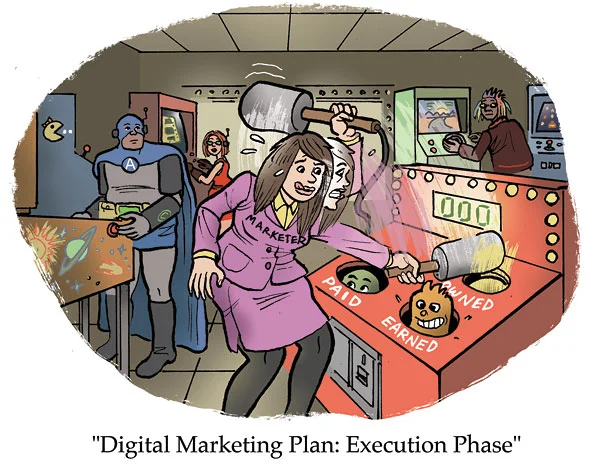You know that oft-quoted axiom about “unknown unknowns” – unexpected and unforeseen conditions that can lead to the failure of a complex system?
Well, programmatic advertising is a very complex system, and it’s got a well-earned reputation for murkiness.
But many of the factors that contribute to opacity in the supply chain aren’t unknown unknowns. Low-quality MFA placements, frequency caps run amok, messed-up measurement and brand safety problems are all known issues.
And they’re often the result – or are at least made worse – by a combination of human error, negligence, failure to adhere to best practices during the initial campaign setup process and then not having enough resources to monitor compliance on a daily basis.
Risky business
Adfidence is a new startup, founded in 2022, that helps advertisers and media planners manage their campaign governance and combat the inefficiencies that plague most programmatic campaigns.
Jerry Daykin, former VP of media at Suntory Global Spirits (previously Beam Suntory), which owns Jim Beam, Maker’s Mark and other well-known spirit brands, has been advising Adfidence since leaving Suntory in January.
Daykin, now a consultant whose résumé also includes senior media roles at Diageo and GSK, was first introduced to Adfidence while he was at Suntory, and the pitch was immediately compelling to him, he said.
And that’s because Daykin, like many brand advertisers, knows what it’s like to “be kept up at night by fear of the front page,” whereby an unfortunate or brand unsafe placement gets captured and covered by the media.
Working with verification providers, namely IAS and DoubleVerify, is useful as “a last line of defense,” Daykin said, but it doesn’t guarantee protection.
The best way to stay safe, he said, is to use a combination of tools. It’s as important to verify the quality and effectiveness of a campaign after it runs as it is to be smart – and careful – about campaign configuration.
Simply ticking the wrong box in an ad platform, for example, is enough to hinder campaign performance. Failing to apply brand safety settings at the outset can expose a brand to high-risk placements. Inconsistent file-naming practices for creative assets makes it almost impossible to generate learnings across ad platforms. And some campaigns don’t even have frequency caps, which leads to media waste and ad fatigue.
An ounce of prevention
And on and on.
In fact, there are hundreds of small ways in which a digital campaign can get off on the wrong foot. Campaign options are often hidden within dozens of confusing settings, and many ad platforms include expanded (and unwanted) inventory by default.
The idea behind Adfidence, whose clients include Kimberly-Clark, Reckitt, Bayer and PepsiCo, is to eliminate the many campaign setup defects that can easily metastasize into bigger problems.
It does this by integrating via API with an advertiser’s measurement vendors and all of the major ad platforms, including Meta, Google Ads, DV360, YouTube, Amazon, Snap, TikTok, Pinterest and The Trade Desk.
From there, it extracts campaign performance attributes and related setup data, such as campaign objective, desired formats, frequency caps and placements. Buyers can select from a menu of roughly 200 rules and best practices for campaign setup and also add in rules of their own.
The platform scores a campaign’s setup based on quality, efficiency, brand suitability, sustainability and media performance. It monitors progress and provides recommendations for how to improve campaigns before they run and while in flight. The data in Adfidence’s system gets refreshed daily.
 If you see something, do something
If you see something, do something
Staying on top of all this would be a gargantuan task for media planners to manage manually, especially for a global advertiser with a portfolio of brands, multiple agency partners and possibly hundreds of accounts across platforms, said Jacek Chrusciany, CEO and founder of Adfidence.
“There are many reasons why mistakes happen, and they happen all the time,” Chrusciany said. “No one is perfect, and no brief is perfect.”
But implementing and automating best practices can give media planners more control and make the campaign execution process more transparent.
Take the twin scandals that erupted last year, both revealed by Adalytics, which called attention to undesirable and brand unsafe placements via YouTube’s audience network and Google’s Search Partner Network.
In both cases, when the news broke, many media buyers appeared not to know that these networks even existed, let alone that they were spending on them. At the time, advertisers were opted into the Search Partner Network by default if they also bought through Performance Max and were largely unaware of this fact.
“Having a strategy doesn’t mean anything if you’re not able to execute it globally across all of your brands,” Chrusciany said. “A lot of these issues can be solved during setup by using inventory filters and inclusion lists and excluding sensitive content categories.”
Still, it’s not always clear how or where to start.
In May, Adfidence partnered with the Brand Safety Institute to launch an online training course to educate advertisers and agencies about the brand safety settings within all of the large digital ad platforms, including Facebook, Instagram and Google’s full suite.
Chrusciany, who’s based in Poland, traveled to New York City in early June to lead a series of campaign setup workshops with global media buyers.
‘It’s our money’
Meanwhile, advertisers are getting louder in their demands for more transparency and control, spurred in part by recent high-profile reports produced by the ANA documenting significant waste in the programmatic media supply chain.
Adfidence is riding this wave of growing awareness, some of which is a result of the fear that advertisers have of the so-called screenshot industry complex. No brand wants to get caught by awkward or unsavory ad adjacencies.
But equally important is the desire to create a supply chain that supports responsible media practices and doesn’t stand in the way of campaign performance.
“As marketers, it’s our money,” Daykin said. “We’re spending millions and millions of dollars – and we don’t want that money going to low-quality environments that don’t meet the standards of our business.”













